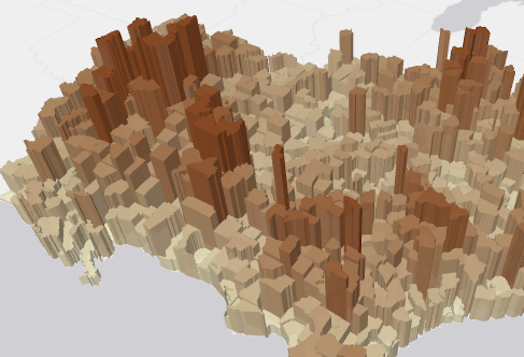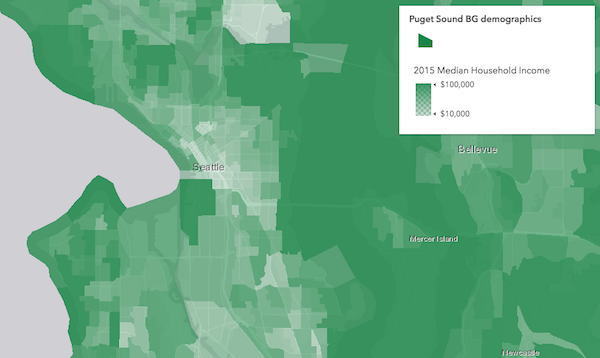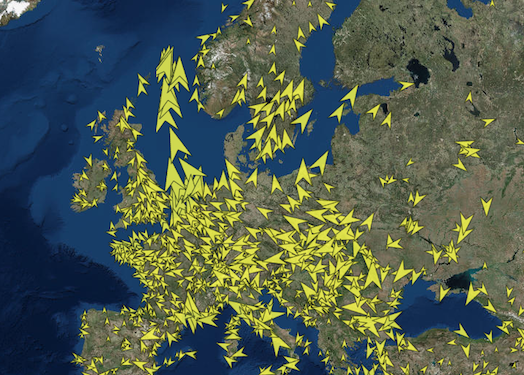require(["esri/renderers/visualVariables/VisualVariable"], (VisualVariable) => { /* code goes here */ });
import VisualVariable from "@arcgis/core/renderers/visualVariables/VisualVariable.js";
esri/renderers/visualVariables/VisualVariable
The visual variable base class. See each of the subclasses that extend this class to learn how to create continuous data-driven thematic visualizations.
Property Overview
| Name | Type | Summary | Class |
|---|---|---|---|
The name of the class. | Accessor | ||
The name of the numeric attribute field that contains the data values used to determine the color/opacity/size/rotation of each feature. | VisualVariable | ||
An object providing options for displaying the visual variable in the Legend. | VisualVariable | ||
The visual variable type. | VisualVariable | ||
An Arcade expression following the specification defined by the Arcade Visualization Profile. | VisualVariable | ||
The title identifying and describing the associated Arcade expression as defined in the valueExpression property. | VisualVariable |
Property Details
-
field
Propertyfield String -
The name of the numeric attribute field that contains the data values used to determine the color/opacity/size/rotation of each feature.
-
An object providing options for displaying the visual variable in the Legend.
-
The visual variable type.
Possible Values:"color" |"opacity" |"rotation" |"size"
-
An Arcade expression following the specification defined by the Arcade Visualization Profile. Expressions in visual variables may reference field values using the
$featureprofile variable and must return a number.The values returned from this expression are the data used to drive the visualization as defined in the stops. This takes precedence over field. Therefore, this property is typically used as an alternative to field in visual variables.
- See also
-
The title identifying and describing the associated Arcade expression as defined in the valueExpression property. This is displayed as the title of the corresponding visual variable in the Legend in the absence of a provided
titlein the legendOptions property.
Method Overview
| Name | Return Type | Summary | Class |
|---|---|---|---|
Adds one or more handles which are to be tied to the lifecycle of the object. | Accessor | ||
Creates a new instance of this class and initializes it with values from a JSON object generated from an ArcGIS product. | VisualVariable | ||
Returns true if a named group of handles exist. | Accessor | ||
Removes a group of handles owned by the object. | Accessor | ||
Converts an instance of this class to its ArcGIS portal JSON representation. | VisualVariable |
Method Details
-
Inherited from Accessor
Since: ArcGIS Maps SDK for JavaScript 4.25Accessor since 4.0, addHandles added at 4.25. -
Adds one or more handles which are to be tied to the lifecycle of the object. The handles will be removed when the object is destroyed.
// Manually manage handles const handle = reactiveUtils.when( () => !view.updating, () => { wkidSelect.disabled = false; }, { once: true } ); this.addHandles(handle); // Destroy the object this.destroy();ParametershandleOrHandles WatchHandle|WatchHandle[]Handles marked for removal once the object is destroyed.
groupKey *optionalKey identifying the group to which the handles should be added. All the handles in the group can later be removed with Accessor.removeHandles(). If no key is provided the handles are added to a default group.
-
Creates a new instance of this class and initializes it with values from a JSON object generated from an ArcGIS product. The object passed into the input
jsonparameter often comes from a response to a query operation in the REST API or a toJSON() method from another ArcGIS product. See the Using fromJSON() topic in the Guide for details and examples of when and how to use this function.Parameterjson ObjectA JSON representation of the instance in the ArcGIS format. See the ArcGIS REST API documentation for examples of the structure of various input JSON objects.
Returns
-
hasHandles
InheritedMethodhasHandles(groupKey){Boolean}Inherited from AccessorSince: ArcGIS Maps SDK for JavaScript 4.25Accessor since 4.0, hasHandles added at 4.25. -
Returns true if a named group of handles exist.
ParametergroupKey *optionalA group key.
ReturnsType Description Boolean Returns trueif a named group of handles exist.Example// Remove a named group of handles if they exist. if (obj.hasHandles("watch-view-updates")) { obj.removeHandles("watch-view-updates"); }
-
Inherited from Accessor
Since: ArcGIS Maps SDK for JavaScript 4.25Accessor since 4.0, removeHandles added at 4.25. -
Removes a group of handles owned by the object.
ParametergroupKey *optionalA group key or an array or collection of group keys to remove.
Exampleobj.removeHandles(); // removes handles from default group obj.removeHandles("handle-group"); obj.removeHandles("other-handle-group");
-
toJSON
MethodtoJSON(){Object} -
Converts an instance of this class to its ArcGIS portal JSON representation. See the Using fromJSON() guide topic for more information.
ReturnsType Description Object The ArcGIS portal JSON representation of an instance of this class.



